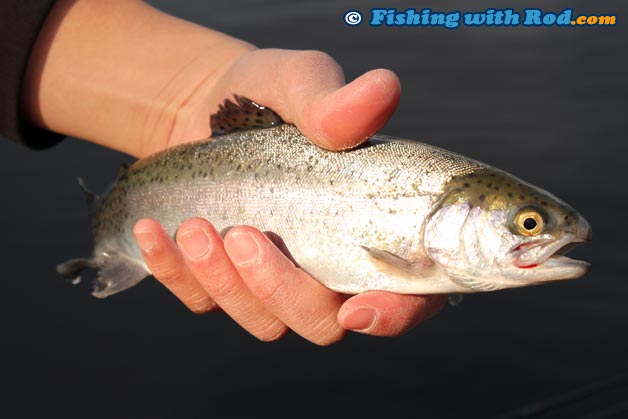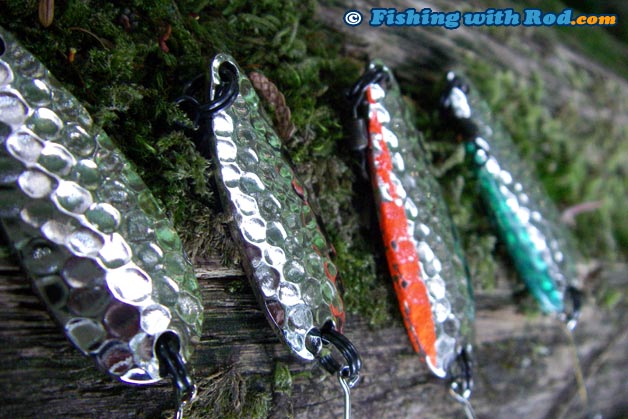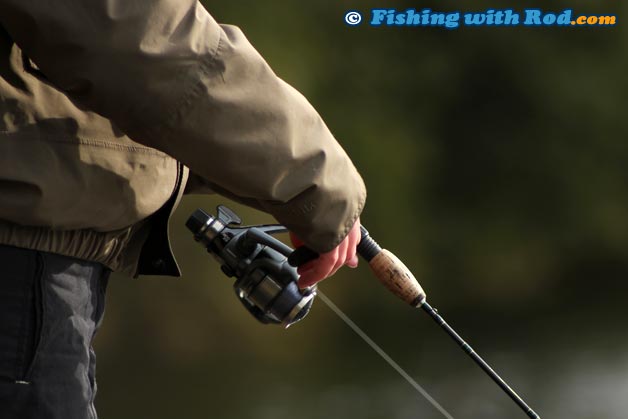Lure Fishing for Stocked Rainbow Trout
By Rodney Hsu, Fishing with Rod | Published in March 2009

British Columbia is well known for its salmon, steelhead and sturgeon fisheries, but they can be a tough challenge for people who have never fished before. To accommodate new anglers, the Freshwater Fisheries Society of BC stocks urban lakes with rainbow trout at catchable size. These rainbow trout, more commonly known as "Fraser Valley rainbow trout", typically weigh between 250g and 500g.
Stocked rainbow trout at catchable sizes are eager biters, which are ideal for entry level anglers and kids who may find it challenging to catch a fish. Urban lakes are typically stocked between March and June, September and November but fish can be caught year-round.
Beside bait fishing, another effective fishing method at urban lakes is lure fishing. Fishing with lures can be a pleasant experience, because it keeps your hands clean and the amount of fishing tackle required is minimal. It can be a challenge to at the beginning, but persistent practice in casting and retrieving will improve your catch rate.
Lure Fishing Tackle

Lure fishing tactics are quite different to bait fishing. Instead of waiting for fish coming to you, you should be looking for fish. This requires the angler to be mobile, so one should not carry too much equipment.
Unlike bait fishing, spinning rods for lure fishing should not be longer than 6 feet. A short rod allows the angler to cast repeatedly without getting sore arms. Some fishing spots do not have much casting space, so a short rod prevents the angler from hooking branches and other obstacles.
Look for a light spinning rod that is rated 2 to 6lb test. A faster, or stiffer, rod maybe needed for better casting and hookset performance. A small spinning reel spooled with 4lb test should be used to balance with your fishing rod. Light line is needed because the size of lures used for stocked rainbow trout is small.
Beside a fishing rod and reel, you simply need a small box that is filled with lures. Two types of lures are commonly used - Spoons and spinners. Both come in different shapes, colours and sizes. Although there is a large selection when it comes to shapes and colours, it does not make much of a difference when fishing for stocked rainbow trout as long as they can detect the presence of the lure. Lighting and water clarity may affect how the lure colour performs, so be sure to switch up from time to time if the lake is not producing. Keep the size of your lure smaller than 1/8oz. Heavier lures may allow you to cast further but they are too big for these stocked rainbow trout.
Lures that are purchased from tackle stores sometimes come with the wrong hook size for rainbow trout. Large hooks may result in missed hook-sets and also damages on small fish that anglers wish to release. Size 4 and 6 long shanked hooks are ideal for lure fishing.
Some anglers may find it difficult to cast small lures. Although additional lead weights can be added to the line, this is not highly recommended. Additional weights may disrupt the lure action and often cause tangles. A better approach would be to work on the casting or find rods, reels and lines that are more balanced with the lures.
Cast and Retrieve

Spincasting lures can be as simple as casting and retrieving. When done repeatedly, a fish would fall for the lure by chance. There are several little tricks that an angler can use to improve success.
Adjusting the retrieving speed is important so you can determine the depth where fish are swimming at. Pausing occasionally during a retrieve can often result in a strike if a fish is following behind the lure. Twitching the lure several times during a retrieve can draw the attention of fish that are swimming nearby.
Many entry-level anglers tend to think that the further he or she casts, the more fish one would catch. This is not entirely true. Too often we focus on what is happening on the other side of the lake than what is in front of us. Rainbow trout do not necessarily swim in deeper water, but they take refuge in structured water where food and protection are available. Underwater structures such as branches and rocks are productive spots. More emphasis should be placed on accuracy than distance when casting. Be flexible on where you should fish. If one spot does not produce after a period of time, don't be afraid to move to other spots.
Lure fishing keeps an angler active on colder fishing days because constant casting and retrieving is required. It only works if the lure is in the water. The "hunting" aspect of this style of fishing makes it attractive for solo, mobile anglers.
Regulations and General Etiquettes
If this is your first stocked lake fishing trip in British Columbia, then you should be aware of existing regulations and some general etiquettes.
Stocked lakes are managed by the BC Ministry of Environment and the BC freshwater fishing regulations apply to them. Some general regulations include:
- You must have a valid BC freshwater fishing license.
- You can only use one fishing rod when fishing from shore, while two fishing rods maybe used if you are in a boat alone.
- You can only use one hook on your fishing rod.
There are exceptions to these regulations at some lakes, such as catch and release only, single barbless hook requirement, and additional boating restrictions. It is your responsibility to be aware of these regulations by checking the BC Freshwater Fishing Regulations Synopsis. If you witness a violation, please report it by phoning 1-877-952-7277 (RAPP).
Stocked rainbow trout are intended to create sportfishing opportunities in urban environment. Anglers are welcome to keep their quota of catches. If a fish is required to be released, please release it in a safe manner by keeping the fish in the water at all time. You can make other anglers' experience at the lake as good as yours by ensuring the survival of your released fish.
General fishing etiquettes also apply in stocked lake fisheries. Please be sure to give other anglers enough space and keep your fishing space garbage free. With your assistance, we can keep our urban lake fisheries a sustainable, enjoyable resource for future generations.

